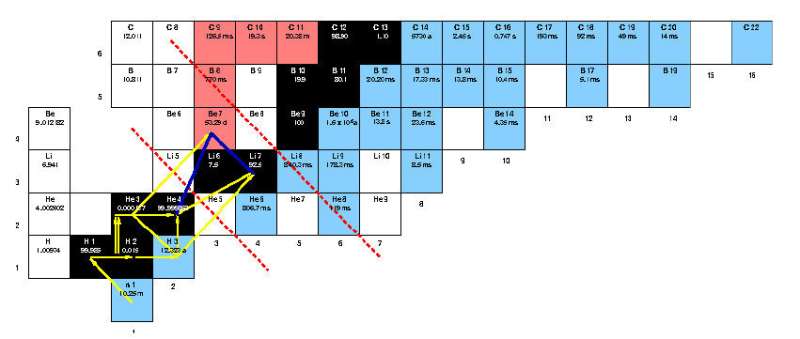The cosmological lithium problem

The international collaborative n_TOF, in which a group of University of Seville researchers participated, has made use of the unique capacities of three of the world's nuclear facilities to carry out a new experiment aimed at finding an explanation of the cosmological lithium problem. This problem is among the still unresolved questions of the current standard description of the Big Bang. The new experimental results, their theoretical interpretations and their implications have been published in Physical Review Letters.
Nuclear reactions responsible for the creation and destruction of atomic nuclei during the Big Bang are crucial in the determining the primordial abundance of lithium, the third (and last) chemical element formed during the very early phase of the creation of the universe. The standard models of the Big Bang predict an abundance of Li7, the main lithium isotope, three or four times more than that actually observed. Recently, at the n_TOF facility at CERN, researchers investigated the possibility of a neutron channel that might be able to increase the destruction rate of the isotope Be7, the precursor of Li7, and therefore make the calculated and observed cosmological abundance of lithium compatible.
"Potentially, a neutron reaction channel might be able to resolve the cosmological lithium problem, which is one of the still unresolved aspects of the current standard description of the Big Bang," says University of Seville Professor José Manuel Quesada.
At the SINQ facility at PSI (Villigen Switzerland) the "uncut" material for use in the new experiment was separated. The material was then sent to the ISOLDE radioactive beam facility at CERN to produce a pure target with less than 0.1 milligrams of Be7, which was then sent to the n_TOF facility to be included in neutron measurements.
This is the first time that the two CERN facilities dedicated to nuclear physics experiments have carried out an experiment together, using the ISOLDE radioactive ion beam to produce the target necessary for an experiment at n_TOF using the neutron time-of-flight technique.
In a previous experiment at n_TOF, the effective section of the 7Be(n,a)4He reaction was measured in a wide range of energies, which allowed for the imposition of strict restrictions on one of the destruction mechanisms of isotope Be7 during the Big Bang. In this experiment, however, the reaction 7Be(n,p)7Li was measured, extending previously acquired data to a greater range of energies, allowing for the updating of the reaction rate used in the calculations in the standard model of the Big Bang.
"Although the new data obtained from the experiments at n_TOF allow for the establishment of a much firmer basis for BBN calculations, the conclusion of this project is that neutron channels are not enough to resolve the cosmological lithium problem. The scientific community has a challenge that will require additional efforts to resolve, and this will involve the fields of nuclear astrophysics, astronomic observations, non-standard cosmology and even new physics beyond the Standard Model of particle physics," the researchers write.
More information: L. Damone et al, Be7(n,p)Li7 Reaction and the Cosmological Lithium Problem: Measurement of the Cross Section in a Wide Energy Range at n_TOF at CERN, Physical Review Letters (2018). DOI: 10.1103/PhysRevLett.121.042701
Journal information: Physical Review Letters
Provided by University of Seville





















